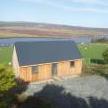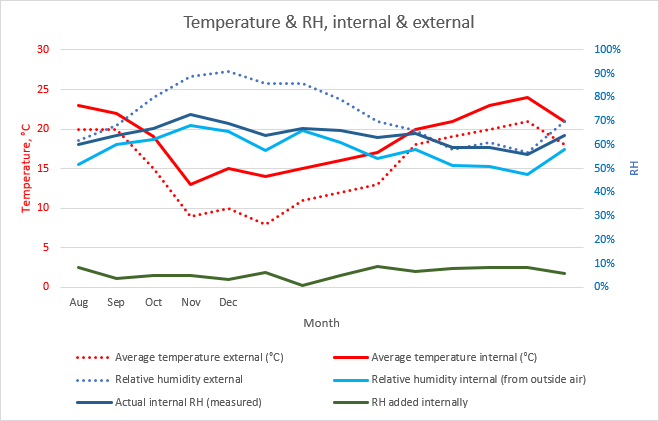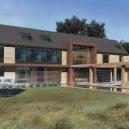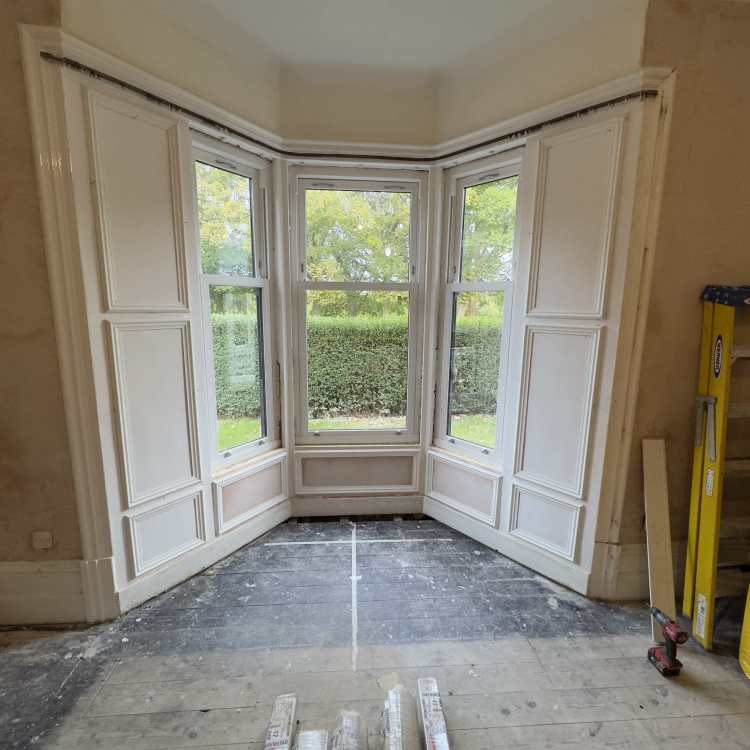Leaderboard
Popular Content
Showing content with the highest reputation on 10/07/24 in all areas
-
So, funny you say that, Jilly. We initially started out planning for a stedding we found but lost to another buyer. We've renovated three properties and I truly believe building from scratch is going to be easier than converting an existing building. We're still doing work on the 1800s build we're in now. Great experience though. Learned to plaster, lay basic central heating, brick slip, tiling, roofing etc. All pretty small jobs, but I recon I can take the skills earned and scale them to some extent.3 points
-
Ok….so if this is more about learning how to design a house yourself, for your needs…..and doing so as an interim source of pleasure until you get your plot (which is exactly what I did),… what I’d advise you to do is design houses based upon actual real plots that you see in your area, or even further afield. As such you’ll learn about how to incorporate your needs into specific plots. I think that would be more helpful as a learning opportunity. Inevitably you’ll get the best advice here based upon actual plot as it’s so incredibly relevant to the house design. but a word of caution….if your house design is your “baby”, as it can sometime be for most of us, be prepared for folk to tell you they think you’ve got an ugly baby Nobody want to do that of course but creative criticism can drive your forward to a better design.2 points
-
Honestly, don’t waste anymore time on this. Wait until you get a plot. That design & layout may be totally unsuitable for the plot you buy. You have some nice ideas, the rear overhang is nice and having the main living / kitchen area are strong. But your interior layout has some obvious problems including basic things like interior hallways with zero natural light, insufficient entrance hallway space, and walking through a room to get to another room. I had my ideas and designs prior to finding a plot. This impacted negatively on my final design as I had a mindset of what I thought we wanted and tried to force that into our design. With hindsight I should have approached my plot with a far more open mind. Keep a portfolio of images, rooms, like the one in your post by all means. When you get the plot either get an architect, get some inspiration from other house designs online, or seek advice here in particular from the likes of those with expertise like @ETC That would be my best and honest advice, but would caveat this by saying it’s your house / your money etc….2 points
-
All you need to know is that if I can do all my plumbing with Hep2o then anyone can! 😉2 points
-
Enjoyed the show and the final reveal. Well done looks amazing! I’m going to visit Turners next week for our TF. Helen did mention they did your house the day before the episode. I take it you would recommend them. They came across well in the show also. Looks like you got additional insulation to the super advanced wall? Would be interested to know more details on the build. A Q&A would be good!2 points
-
As you’ve budget for piles and you might end up there, bear in mind it’s worth getting several quotes as I found a vast difference in price. The muck away is astounding, you’ll save a lot of you have somewhere on site to get rid of the spoil.1 point
-
It's not a case of being told to throttle back, it's planning ahead for what happens when there is no wind and no sun at the same time as peak demand.1 point
-
Firstly, glad you found my link to BGS useful. Welcome to the exciting and detailed world of engineering geology. On the above, it’s is geologically impossible for sandstone to form above a Holocene clay. Therefore your ‘thin layer of sandstone’ is 99.9% a cobble. Ignore it for design, but factor it for digging. That SPT (incorrectly labelled CPT) is refusing on the cobble E.g. 50 blows for 15mm. So other than the SPT of 7 shallow you don’t have any insitu data. The U100 results would be useful, but unlikely to be attached to the log. I haven’t digested every detail of this thread, but I suggest (as others have done) you find a SE and get their advice. I design piles regularly (for bridges and large structures, not houses) but even with nearly 20 years of experience, I couldn’t teach you foundation design on t’internet. the SE will know how to navigate Building Regs, which I’d suggest is more relevant than your perceptions of ‘sufficient bearing’. My 2c for a ‘feel’ before spending money : dig a slit trench to 2m (your proposed trenchfill limit) then: 1. See how long it takes for water to fill it 2. if it stays (relatively) dry get a sample from the base and try to stick your finger in it. If you can, probably too weak at 2m depth if it floods quickly, that makes trench fill less appealing (H&S warning: dig with excavator if possible and don’t get in the pit. If you have to hand dig, make it wide and step the sides out)1 point
-
1 point
-
Yes, straight. So as the come out of the wall I convert to copper so it looks nice and need under sinks etc. but each to their own. @Pocster has Hep2o all the way to the outlet.1 point
-
ps. it doesn't need to be ugly. but as @Nickfromwales says, I used copper for the most part as it comes out of the wall to the outlet as copper does look better on show. but copper fits straight in to the push fit fittings and so a couple of lengths of 15mm copper pipe is all you really need and zero soldering skills.1 point
-
Because your neighbours are nutters I’d definitely run it past your local planners. And ideally incorporate barbed wire & a machine gun post in your design. But surely as you are elevated above them would you need to go as high as 2m?1 point
-
https://www.engineeringtoolbox.com/salt-humidity-d_1887.html and https://imatrixsys.com/multi-point-relative-humidity-calibration/ I did mine in a marge tub with a small pot of salt and water and multiple sensors next to it. The important thing with NaCl is that for room temperatures, the relative humidity over the salt solution stays pretty constant in the 75-75.75% range. Leave the sensors to reach equilibrium (2-3 days) and record the difference for each sensor and then in HomeAssistant change the offset value.1 point
-
Another area to explore is converting an existing building, barn, stable etc. More/different loopholes to jump through, plus, it could go over your budget.1 point
-
>>> using the design process to understand what we want, as a learning tool Yeah, that's a perfectly valid design technique. You're the customer, do whatever you want. You might like to consider what orientations (sun, views etc) work well with your designs. As are mood boards, magazine clipping files, physical models etc etc etc. If you have the time and energy, there's nothing to stop you thinking about construction teechniques, insulation amounts, plant etc. And reading the 'ub here to learn a lot.1 point
-
1 point
-
…and if your struggling to find a plot have you considered buying something to demo…that’s how we did it as couldn’t find a suitable plot in the right location.1 point
-
I can give no advice other than keep looking and something will find you! That is the attitude that we had and after 2 years of looking at sites that were OK, but didn't float our boat. Eventually ours came up at auction and we just knew it was meant for us and that we could at last scratch an itch that had been there for 30 years or so. When we were looking we really had no idea of what our build would look like, single storey/two storey/orientation/size none of this was something we thought about. When we found the plot we started looking at what we might build and by a process of elimination came to our submitted plan. (After months of sorting out a discrepancy in the boundary that was on the LR plan!)1 point
-
I was going to edit my post to add that at the end of the day it is totally up to you how you approach this. It's an exciting time working towards a self-build and for us, as soon as we got the land it soon became apparent in lots of ways what we would attempt to build. There is also some merit in looking at options and posting on here as people will point out, what appears to them, glaring errors! At your stage they are not errors just points on a path. Good luck with looking for land - in some ways that is the hardest part of the process! Actually getting PP is the hardest part, or maybe building it 😁1 point
-
Gotcha. Seems like a theme. Not sure if people are missing what I'm trying to achieve (using the design process to understand what we want, as a learning tool, and because we enjoy it) or if I am being completely naive and wasting my time and others by posting this here. Apologies if it's the latter.1 point
-
Have to agree with Bozza re spending time on a layout before you have the plot, I'm really not so sure that you are helping yourself to be honest. The plot you buy will give you so much more regarding orientation and shape and layout than any theoretical exercise! I worked as an AT for 10 years or so and the last thing I ever wanted on first look at a potential change to a property was other people ideas, for me it took away some of the spontaneity that happens when you look at something with fresh eyes.1 point
-
As I said earlier I've been logging for a while My External Sensor (Tempo and Humidity) is actually in a well ventilated loft My Internal Sensor (Temp and Humidity is in one of the bedroom) Hopefully this table will work OK Month Avg External Temp Avg External Humidity Avg Internal Temp Avg Internal Humidity Aug-23 20 62% 23 60% Sep-23 20 68% 22 64% Oct-23 15 80% 19 67% Nov-23 9 89% 13 73% Dec-23 10 91% 15 69% Jan-24 8 86% 14 64% Feb-24 11 86% 15 67% Mar-24 12 79% 16 66% Apr-24 13 70% 17 63% May-24 18 66% 20 65% Jun-24 19 58% 21 59% Jul-24 20 61% 23 59% Aug-24 21 57% 24 56% Sep-24 18 70% 21 64% Interested in Mike's xls sheet I plugged this years data into it1 point
-
Well we did spend 623k on trades, so it's not like we were building the whole thing ourselves. We did a lot, and got really hands on, but we didn't build the whole thing. Please don't get that assumption. Many evenings after work and some early mornings too can be included into that. And any holidays we had with work, we spent that on-site working.1 point
-
Thanks very much for your kind words. Glad you enjoyed the episode. In terms of the planning, there was a historical consultant that carried out some research on the land. Some historical maps were pulled, looking what was on the land before, years ago. In this case - a historical malthouse. These were easily obtained for free, from the National Library Of Scotland. It's quite fascinating to have a nose around to see what was where you live hundreds of years ago anyway! The planners were really onboard with the idea of restoring a heritage building, albeit, all we found on site were some old footings, a few bricks (nothing that would pass regs nowadays obviously). A design was put together to pay homage to the old malthouse (the front had to look quite traditional), but at the same time, as it's a new building, bring a modern take to it. Which is the Corten glass portal, and the more contemporary rear. Hope that adds a bit of insight, but let me know if there's any others questions, happy to answer.1 point
-
Good point. 2 layers with overlaps will always have gaps and movement. For a thick concrete slab the pir will certainly crush into shape. For a thin screed I would definitely still do a preload by walking on it in very big flat shoes or moving a board around. 70mm of screed will weigh about 15kN/m2. That should do the local bending and crushing.1 point
-
Did you / have you looked at the Siga Hygrobrid one-way membranes? Their data is hidden behind a login wall, the best link I can find is https://www.architectureanddesign.com.au/getattachment/c5861842-768b-451a-badf-fbedef41e1f3/attachment.aspx Alan Budden used the Siga Marjrex single directional vapour control layer in his retrofit and said it allowed extra IWI than moisture calculations without it did. A little more data here on page 9 of this transcript at 21:10.1 point
-
Your over thinking it There’s so much weight going on the top of the insulation it will all flatten down once the screed goes down Insulation always rocks till you get some weight on it Spend time making sure the membrane is properly taped Don’t make work for yourself Your builder will tell you the same1 point
-
Copper, where it's the plant room or where the pipe is exposed and mechanical damage/aesthetics are important, every damn day of the week. Everywhere else, Hep2O is the weapon of choice. JG Speedfit still remains my go-to for pressure testing/temporary hook-ups, but tbh......a fitting which slowly undoes itself over time is not something that really instills confidence. I go to sites where folk have used this stuff for welfare setups etc, and each and every joint has begun to undo, and none have the 'obligatorily forgotten' circlip fitted which sends a cold shivver down my spine of how many of these are installed in homes and are ticking timebombs....? Put a Hep2O fitting together, do the same with JG, and have a look for yourself as to the difference. Night and day IMHO.1 point
-
Yes Wilo are quiet but I would be surprised if there was no detectable sensation when it was running. If changing the speed setting from I to III makes no perceptible difference I would guess it is probably seized, you might have to take it out (which is when you discover the valves do not shut off or the spindles leak).1 point
-
Just caught up with the episode. @thefoxesmaltings, well done with your build. What a stunning home you have both created. How you spent your budget must give a lot of hope for what can be done. I’m sure there are many plots of land with footing for old buildings, that could yield planning permission for others. I’m sure more details on that part of the journey would be quite enlightening.1 point
-
The only way I solved whether mine was getting enough flow rate or not was to fit an in line flow meter. If you are not hearing any noise, it could be the pump is seized, but the Wilo pumps are one of the quietest pumps available.1 point
-
As said Hep is best and in my opinion a superior fitting to JG speedfit and polyplumb. Keep the pipe clean and scratch free, make sure ALL the pipe is cut using a proper cutter. Use the barrier pipe with the Hep stainless steel insert in every fitting . The majority of all new builds use this system now and if installed currently it is trouble free . One downside I have seen several times now is rodent attack1 point
-
Amazing build! No idea how you did that with the budget you had. Mightily impressed by your hard work and tenacity. Well done!1 point
-
1 point
-
It would be great to get an update on this and how you have been getting along with the system. Specifically, did you ever get a satisfactory answer to the question about the Arotherm ASHP internal pump. More specifically, does it keep running 24/7/52 at the minimum 9l/min even when the compressor is not operating? or is it doing something a little more energy efficient and turning off, then occasionally on to sense return temperature? yours is the only online post I have seen asking about this behaviour and it seems relatively important when operating systems completely open loop as is becoming more common.1 point
-
Although folk on BH may disagree, SE's and Architect's often work on quite a tight business model, especially if they employ folk. I offer from time to time offer a service where folk pay me for an intial SE consultation. But as I used to be a building contractor in my last life this turns in to a general over view. This starts off with a phone call and a general chat, I ask a few questions but mostly try to listen, then I identify what initial info we need to make some basic decisions. I try and explain why we need to do things and answer any questions you have.. the objective is to inform you as much as I can and give you the tools to make your own decisions. Part of this process allows me gauge how knowledgeable your are and where you may need help. You can cover a huge scope in a couple of hours on the phone. My approach is to say up front.. here is my hourly rate for; general advice, a supportive chat and advice on the process of selecting other advisors / designers and how you put together a document that specifies what you think you need and importantly where you think you may need help. At the end of the day I always make sure that folk feel they have got value for money, usually this results in over all savings and that justifies my fee. What I do is different but it does work for some Clients and me. Try if you can to find an experierienced SE who will spend a couple of hours chewing the fat with you.1 point
-
Yes but the output from the 12kW unit is so much that it would be highly desirable to be able to run the compressor at less than the 50% setting that Eco mode gives you. Then there would be less delta T across the coil and even better CoP. Have been in correspondence with Vaillant tech about this but they have not been able to suggest anything useful. Just back from hol and will post some more analysis when I have crunched the figures a bit further.1 point
-
I was going to suggest @Trw144 price may reflect the power of bulk buying? but then @haythorn_1 is buying 2x my area and looks to be more expensive. It likely depends on how many non-windows (lift& slde/paito/entry doors) there are. My internorm quote (April 2024) for 22.4m2 (1 lift& slide, 1 front door, all else T&T) was £939/m2 + fitting + VAT! At least delivery is included in that price 😕 GBS and Zyle are coming in at about £800/m2. Rationel, NordVest and others looking a little more sensible at <£700/m2 (+ fitting + VAT) but it's all rather eye-watering. Performance wise, GBS, Zyle and Internorm have average Uw values around 0.75 W/m2K for my window list. That drops to 0.85-0.89 for the less expensive ones. So for a 0.1 W/m2K hit in Uw at a peak difference of 30K (-10 C out/20C in) over the area (22.4 m2) that's only 67 W difference ....is that about right? If so, I'm not seeing how I'm ever going to realise the benefit of the extra investment up front. Have I missed something here?1 point
-
Yes, the short height fence you can see is the boundary. The block wall is on my side and is mine. I'd be building the fence behind that. I would, but unfortunately on the one side in particular down there they are "characters" who are very likely to oppose anything as they've fought tooth and nail against other minor developments in the area previously and seem to have the council on speed dial. I caught them once having climbed over the fence for a wander around my garden, and they've also been caught in other neighbours gardens just to put it into perspective. But yes, in normal circs with normal neighbours a quick chat would no doubt get the job done.0 points
-
0 points
-
You just need a robust ventilation strategy, my curtains blow about isn't a ventilation strategy. Don't you need to measure the relative humidity instead of absolute?0 points














